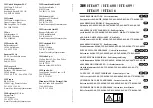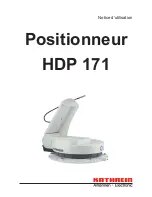
MX-FNX9 SELF DIAGNOSTICS AND TROUBLE CODES 9 – 2
Phenomenon
A document is discharged to the reverse path in the
operation other than reverse operation.
Case 1
Cause
Flapper solenoid (FINRPS) connector pin
trouble
Check &
Remedy
Check the connection state of the connector.
(CN15)
Case 2
Cause
Solenoid coil disconnection
Check &
Remedy
Perform the conduction test of the coil. If there
is no conduction, replace the coil.
Case 3
Cause
Control PWB trouble
Check &
Remedy
If the flapper solenoid (FINRPS) does not
operate in the solenoid single operation mode,
replace the control PWB.
Phenomenon
The belt separation solenoid (FBRS) does not operate.
The paper surface detection solenoid (FSLS) does not
operate
The paddle one-rotation solenoid (FPDS) does not
operate.
Case 1
Cause
Solenoid connector pin trouble
Check &
Remedy
Check the connection state of the connector.
(CN15, 20)
Case 2
Cause
Solenoid coil disconnection
Check &
Remedy
Perform the conduction test of the coil. If there
is no conduction, replace the coil.
Case 3
Cause
Control PWB trouble
Check &
Remedy
If the solenoid does not operate in the single
operation mode of the belt separation solenoid
(FBRS), the paper surface detection solenoid
(FSLS), or the paddle one-rotation solenoid
(FPDS), replace the control PWB.
Phenomenon
The take-up belt does not operate normally.
Case 1
Cause
Take-up belt sensor (FBRD) trouble
Check &
Remedy
Measure the voltage of TP13 on the control
PWB to confirm that it is 5V
±
5% when the belt
descends, and is 1V or less when the belt
separates. If the voltage does not satisfy the
above condition, replace the sensor.
Case 2
Cause
Control PWB trouble
Check &
Remedy
If the phenomenon is not removed though the
sensor level is changed by turning ON/OFF
each sensor, replace the control PWB.
Phenomenon
The staple shift motor does not operate.
Trouble code: F1-08
Case 1
Cause
Stapler HP sensor (FSTHPD) trouble
Check &
Remedy
Measure the voltage of TP7 on the control
PWB to confirm that it is 5V
±
5% when the
stapler unit is pushing against the front side
(home position), and is 1V or less when the
stapler unit is pushing against the rear side. If
the voltage does not satisfy the above
condition, replace the sensor.
Case 2
Cause
Motor coil disconnection
Check &
Remedy
Perform the conduction test of the coil. If there
is no conduction, replace the coil.
Case 3
Cause
Control PWB trouble
Check &
Remedy
After checking the above 1 to 2, if the
phenomenon is not removed though the
sensor level is changed and if the motor does
not operate in the motor single operation
mode, replace the control PWB.
Phenomenon
The stapler does not operate. Trouble code: F1-10
Case 1
Cause
Alignment plate position sensor (FJPD) trouble
Check &
Remedy
Measure the voltage of TP50 on the control
PWB to confirm that it is 1V or less when the
stapler is at the paper rear edge stopper
section, and is 5V
±
5% when the stapler is not
at that position. If the voltage does not satisfy
the above condition, replace the sensor.
Case 2
Cause
Stapler home sensor (FSHPD) trouble
Check &
Remedy
Measure the voltage of TP51 on the control
PWB to confirm that it is 5V
±
5% at the stapling
mechanism home position, and is 1V or less
when stapling. If the voltage does not satisfy
the above condition, replace the stapler.
Case 3
Cause
Self priming sensor (FSTD) trouble
Check &
Remedy
Measure the voltage of TP52 on the control
PWB to confirm that it is 5V
±
5% when a
cartridge is provided (READY state), and is 1V
or less when a cartridge is not provided. If the
voltage does not satisfy the above condition,
replace the stapler.
Case 4
Cause
Staple empty sensor (FSD) trouble
Check &
Remedy
Measure the voltage of TP53 on the control
PWB to confirm that it is 5V
±
5% when a
cartridge is provided (with staples), and is 1V
or less when a cartridge is not provided. If the
voltage does not satisfy the above condition,
replace the stapler.
Case 5
Cause
Motor coil disconnection
Check &
Remedy
Perform the conduction test of the coil. If there
is no conduction, replace the stapler.
Case 6
Cause
Control PWB trouble
Check &
Remedy
After checking the above 1 to 5, if the
phenomenon is not removed though the
sensor level is changed and if the motor does
not operate in the motor single operation
mode, replace the control PWB.
Phenomenon
The tray does not operate. Trouble code: F1-15
Case 1
Cause
The paper surface sensor 1 (FSLD1), paper
surface sensor 2 (FSLD2) trouble
Check &
Remedy
Measure the voltage of TP5 and 6 on the
control PWB to confirm that it is changed in the
range of 1V or less to 5V
±
5% when the paper
holding lever is moved. If the voltage does not
satisfy the above condition, replace the
sensor.
Case 2
Cause
Tray upper limit sensor (FULD) trouble
Check &
Remedy
Measure the voltage of TP1 on the control
PWB to confirm that it is 1V or less when the
tray is at the upper limit position, and is 5V
±
5%
when the tray is not at the upper limit position.
If the voltage does not satisfy the above
condition, replace the sensor.
Case 3
Cause
Tray intermediate lower limit sensor (FMLLD)
trouble
Check &
Remedy
Measure the voltage of TP2 on the control
PWB to confirm that it is 1V or less when the
tray is at the intermediate position, and is
5V
±
5% when the tray is not at the intermediate
position. If the voltage does not satisfy the
above condition, replace the sensor.
Case 4
Cause
Tray lower limit sensor (FLLD) trouble
Check &
Remedy
Measure the voltage of TP3 on the control
PWB to confirm that it is 1V or less when the
tray is at the lower limit position, and is 5V
±
5%
when the tray is not at the lower limit position.
If the voltage does not satisfy the above
condition, replace the sensor.
Case 5
Cause
Motor coil disconnection
Check &
Remedy
Perform the conduction test of the coil. If there
is no conduction, replace the stapler.
















































